Related Items, Signature

Paradise Lost.
Signature on tri-party marriage indenture, 27 November 1623.
Purchased by J.P. Morgan, Jr., 1919
1668 Edition
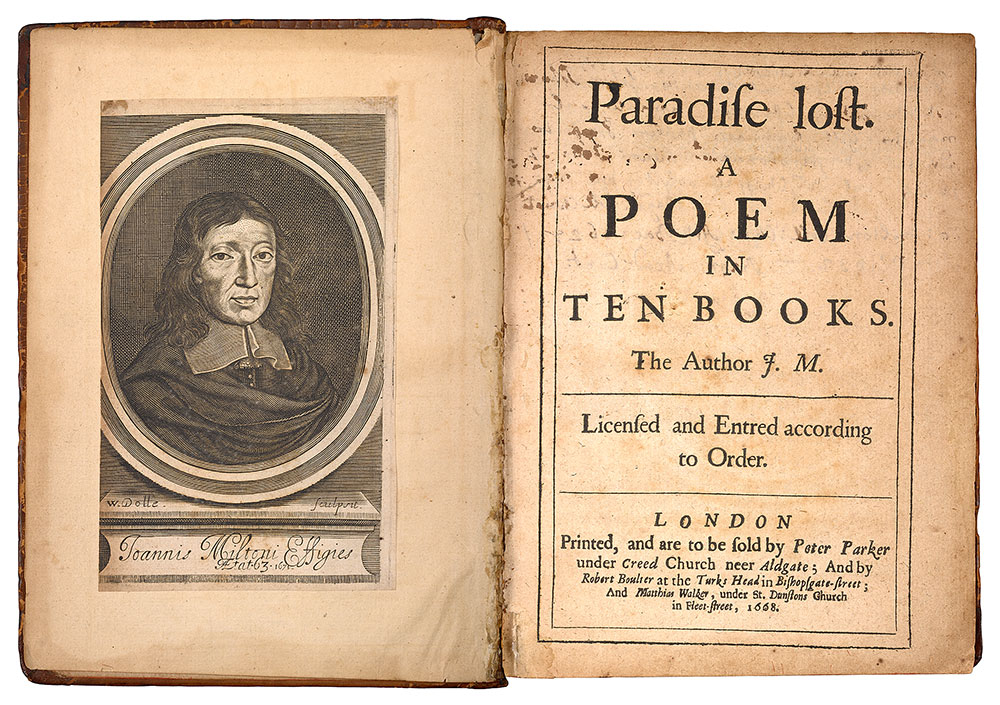
Paradise Lost.
London: Printed, and are to be sold by Peter Parker under Creed Church neer Aldgate; and by Robert Boulter at theTurks Head in Bishopsgate-street; and Matthias Walker, under St. Dunstons Church in Fleet-street, 1668.
Purchased by Pierpont Morgan, 1912
The bibliographer Hugh Amory argues persuasively for this being the earliest issue of the first edition of Paradise Lost (despite its title page, dated 1668), in which the anonymous author is identified only by his initials, "J. M." Similarly, the author is identified in the Stationers' Register on 20 August 1667 by his initials only. Amory speculates that Samuel Simmons, the printer and publisher of the first edition, decided against using Milton's full name on the title page "as the day of publication approached," substituting this version on which the author remained anonymous. Simmons's faltering confidence is understandable because Milton, a prominent supporter of regicide (he defended the execution of Charles I), was still widely regarded as a dangerous radical when Paradise Lost was first published.
1667 Edition

Paradise Lost.
London: Printed, and are to be sold by Peter Parker under Creed Church neer Aldgate; and by Robert Boulter at the Turks Head in Bishopsgate-street; and Matthias Walker,under St. Dunstons Church in Fleet-street, 1667.
Purchased by Pierpont Morgan
As sales of the book improved, and perhaps after the royal library had accepted a presentation copy (the king's copy is displayed in the next case), Simmons's anxiety subsided, and he began to draw from the stock of alternative title pages. Milton's full name was retained on the title pages of the first edition in 1668 and 1669. The book was never issued with a frontispiece portrait of the author. The portrait that appears opposite the title pages of these copies is William Dolle's engraving (after William Faithorne's painting of Milton), published in the second and third editions (1674 and 1678), and inserted into these copies of the first edition at a later date.
Book 1

Paradise Lost.
Licensed and Entred [sic] according to Order. London: Printed [by Samuel Simmons], and are to be sold by Peter Parker under Creed Church neer Aldgate; And by Robert Boulter at the Turks Head in Bishopsgate-street; and Matthias Walker, under St. Dunstons Church in Fleet-street, 1667.
Purchased by Pierpont Morgan
1668 Edition

Paradise Lost. A Poem in Ten Books. The Author / John Milton.
London: Printed by S. Simmons, and to be sold by S. Thomsonat the Bishops-Head in Duck-lane, H. Mortlack at the WhiteHart in Westminster Hall, M. Walker under St. Dunstans Church in Fleet-street, and R. Boulter at the Turks-Head inBishopsgate street, 1668.
Gift of Dr. Karl Vogel, 1957
This 1668 reissue was the first to include Milton's synopsis of each book ("the Arguments" of Books 1–10), his defense of "the Verse," and a list of errata, adding sixteen pages of preliminary matter to the book. Simmons's note to the reader states that he had procured this explanation from Milton because readers of the poem had "stumbled" on first encountering it, asking "why the Poem Rimes not." Milton's strident defense of blank verse (unrhymed iambic pentameter) is printed in large type that fills two pages. His chosen meter, although no longer fashionable by 1667, was the dominant mode of Shakespeare's plays and is the closest to the natural rhythms of English speech. Samuel Johnson later commented sarcastically that, "finding blank verse easier than rhyme, [Milton] was desirous of persuading himself that it is better."
Charles II Copy

Paradise Lost. A Poem in Ten Books. The Author John Milton.
London: Printed by S. Simmons, and to be sold by S. Thomsonat the Bishops-Head in Duck-lane, H. Mortlack at the WhiteHart in Westminster Hall, M. Walker under St. DunstansChurch in Fleet-street, and R. Boulter at the Turks-Head inBishopsgate street, 1668..
Gift of Caroline Newton, 1970
When Charles II was restored to the English throne in 1660, he issued a proclamation calling for two of Milton's books to be publicly burned by the hangman. This is a magnificent association copy, bound in full contemporary red morocco and stamped in gilt with the cipher of Charles II, consisting of crowned Cs and palm leaves in five of the six spine panels. The endpapers also bear a watermark with the arms of Charles II. The royal binding is attributed to Samuel Mearne. The gilt stamped spine reads Paradice Lost, the title as it was entered in the Stationers' Register on 20 August 1667. This copy has the 1667 title page bound, as printed, at the end.
1777 Edition
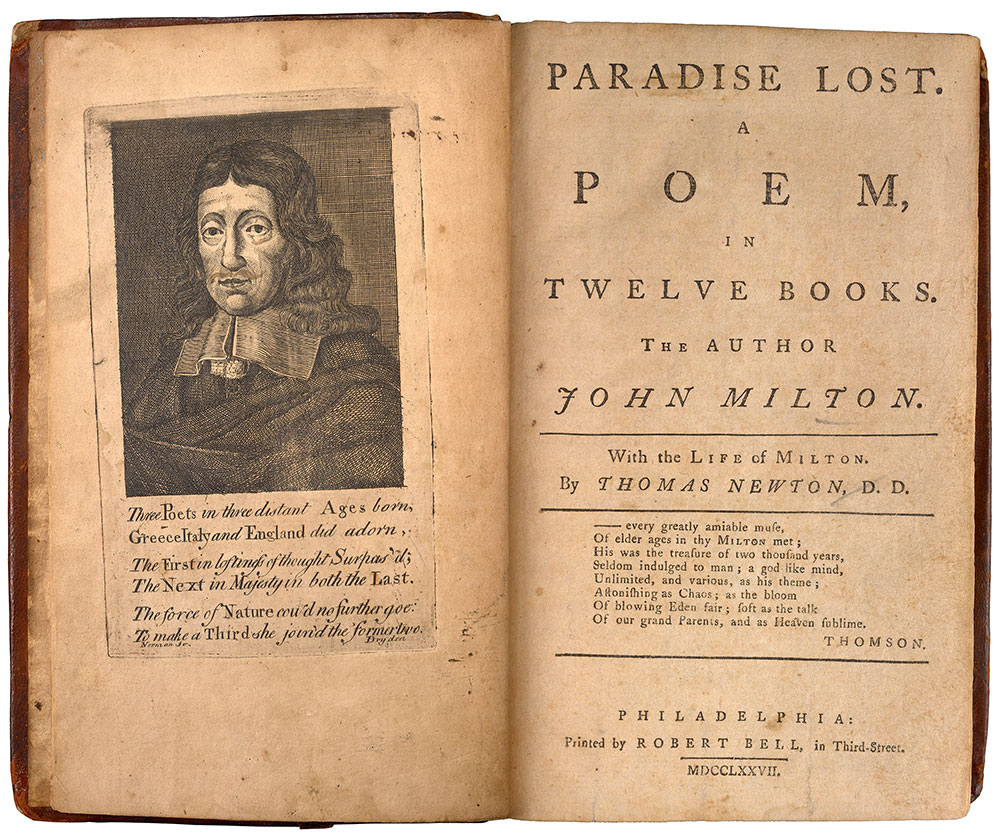
Paradise Lost: A poem, in Twelve Books. The Author John Milton. With the life of Milton. By Thomas Newton,D.D. [Eight lines from Thomson]
Philadelphia: Printed by Robert Bell, in Third-Street, 1777.Vol. I.
Purchased by Pierpont Morgan, 1911
Over a century after the first publication of Paradise Lost in London, the Philadelphia printer Robert Bell, perhaps inspired by the Revolution, ignored British copyright and published this two-volume edition of Milton's work. This is the extremely rare first American edition, in contemporary sheep binding with a frontispiece portrait engraving by John Norman, to which a previous owner has added a moustache in ink. Milton had long enjoyed a high reputation in this country. Thomas Jefferson, like many of his contemporaries, regarded Milton as one of the greatest poets of the English language. In his essay "Thoughts on English Prosody," he declared blank verse to be "the most precious part of our poetry," citing the opening of Paradise Lost as an example.
Areopagitica

Areopagitica; A Speech of Mr. John Milton For the Liberty of Vnlicenc'd Printing, To the Parlement of England. London, Printed in the Yeare, 1644.
Purchased by Pierpont Morgan
Galileo, p. 1
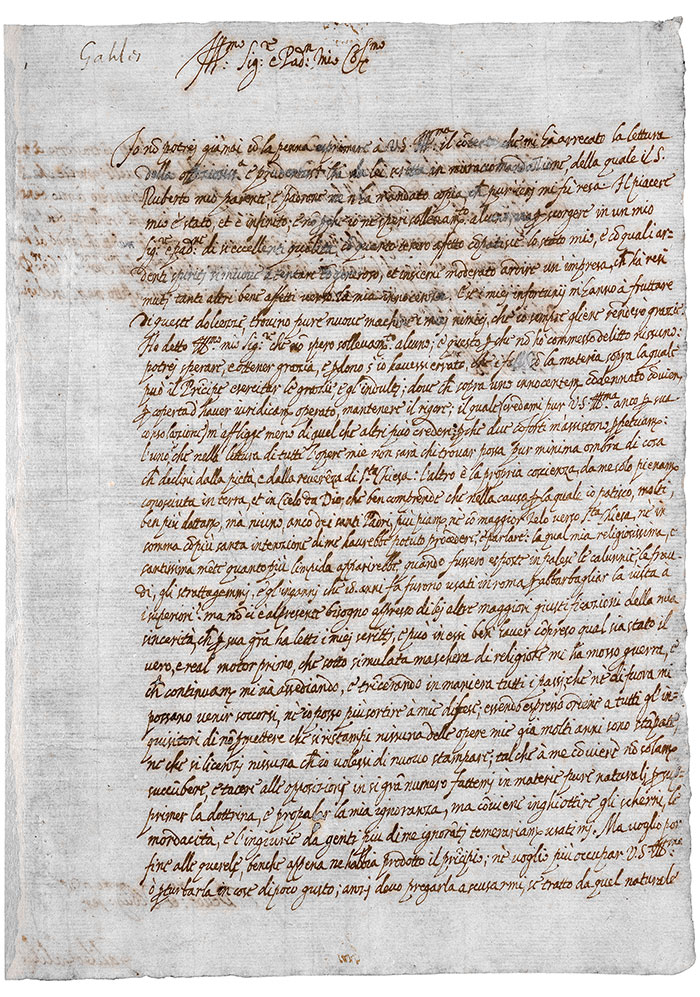
Autograph letter signed, Arcetri, to Nicholas Fabri de Peiresc, 21 February , 1635.
Purchased by J.P. Morgan, Jr., 1928
Galileo, p. 2

Autograph letter signed, Arcetri, to Nicholas Fabri de Peiresc, 21 February , 1635.
Purchased by J.P. Morgan, Jr., 1928
A Proclamation

By the King. A proclamation for calling in and suppressing of two books written by John Milton: the one intituled, Johannis Miltoni Angli pro populo Anglicano defensio, contra Claudii Anonymi alias Salmasii, defensionem regiam, and the other in answer to a book intituled, The pourtraicture of His Sacred Majesty in his solitude and sufferings: and also a third book intituled, The obstructors of justice, written by John Goodwin / by the King.
London : Printed by John Bill and Christopher Barker, Printers to the Kings most Excellent Majesty, 1660.
Purchased by Pierpont Morgan, 1910
Defensio
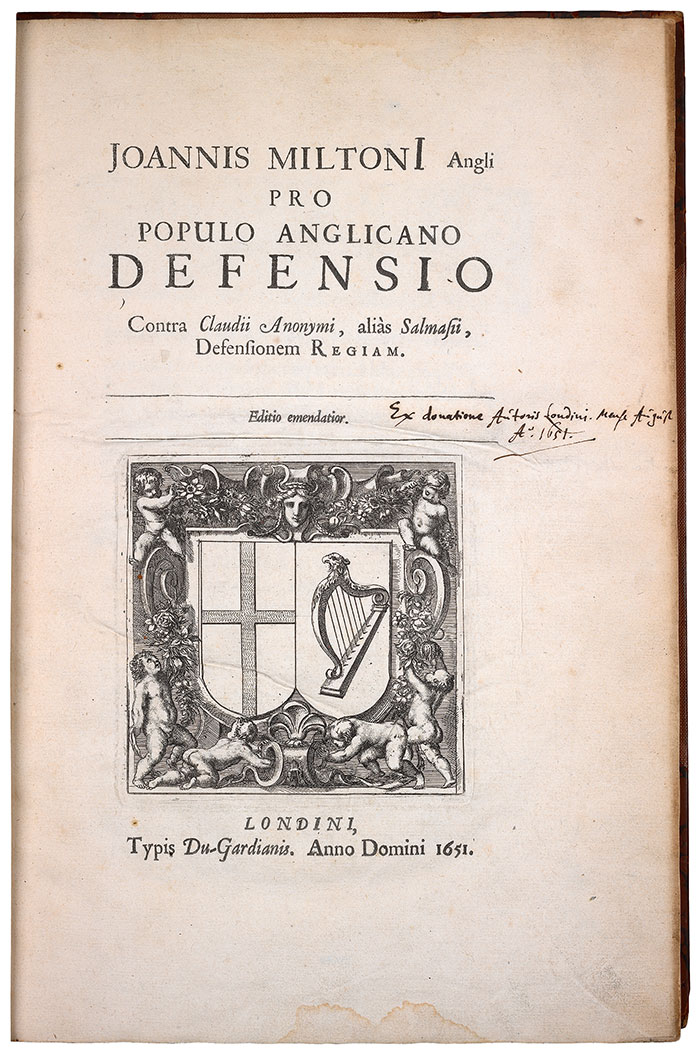
Joannis Miltoni Angli Pro populo Anglicano defensio: contra Claudii Anonymi, alias Salmasii, Defensionem regiam. Londini: Typis Du-Gardianis, Anno Domini 1651.
Purchased by Pierpont Morgan, 1910
1688 Edition

Paradise Lost. A Poem in Twelve Books. / the authour JohnMilton. The fourth edition, adorn'd with sculptures.
London: Printed by Miles Flesher, for Richard Bently,at the Post-Office in Russell-Street, and Jacob Tonson at theJudge's Head in Chancery-lane near Fleet-street, 1688.
Gift of George Blumenthal, 1941
By 1688, when England was on the verge of the Whig revolution, Milton's reputation had revived considerably. He was commended for his republicanism as well as his record as a defender of liberty. His supporters believed that his greatest poetic achievement merited this handsome, monumental edition. One of the earliest examples of subscription publishing, financed by Lord Somers, the fourth edition of Paradise Lost was the first to be printed in folio format and is the first illustrated edition, distinguished by high quality paper, large, clear type, and ample margins. Milton had previously reorganized the poem into twelve books (by splitting Books 7 and 10 of the original) to parallel Virgil's Aeneid more closely. Full-page illustrations by John Baptiste de Medina, Bernard Lens, and Henry Aldrich precede each of the twelve books in this edition.
1777 Edition
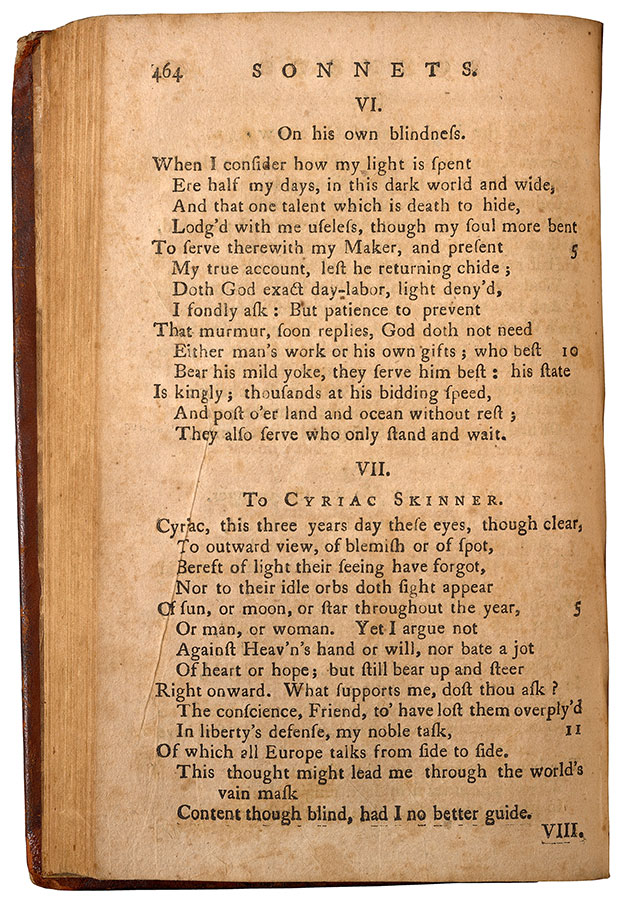
Paradise Lost: A poem, in Twelve Books. The Author /John Milton. With the life of Milton. By Thomas Newton,D.D. [Eight lines from Thomson]
Philadelphia: Printed by Robert Bell, in Third-Street, 1777.Vol. II.
Purchased by Pierpont Morgan, 1911
In Bell's edition, Milton's two sonnets on the subject of his blindness are printed together on one page. Sonnet 22 (here numbered VII) is a Petrarchan sonnet addressed to his pupil and friend, Cyriack Skinner (1627–1700). Written in late 1654 or early 1655, three years after Milton had become totally blind, it remained unpublished during Milton's lifetime. The manuscript is written in Skinner's hand, indicating that Milton dictated it to him. Both sonnets innovatively blur the distinction between the octave and sestet, continuing the syntax and sense between the eighth and ninth lines by enjambment to more closely approximate the natural rhythms of the speaking voice. This fluidity and continuity, in which, according to Milton's note, "the sense [is] variously drawn out from one verse into another," is also a notable element in the poetic accomplishment of Paradise Lost.
Cyriack, this three years day these eys, though clear
To outward view, of blemish or of spot;
Bereft of light, thir seeing have forgot,
Nor to thir idle orbs doth sight appear
Of Sun or Moon or Starre throughout the year,
Or man or woman. Yet I argue not
Against heavns hand or will, nor bate a jot
Of heart or hope; but still bear up and steer
Right onward. What supports me, dost thou ask?
The conscience, Friend, to have lost them overply'd
In libertyes defence, my noble task,
Of which all Europe talks from side to side.
This thought might lead me through the worlds vain mask
Content though blind, had I no better guide.
Miniature

Miniature portrait of an unknown man,believed to be John Milton
Watercolor on vellum
Gift of J. P. Morgan, Jr.
This portrait of a middle-aged man, costumed in a black buttoned vest, black gown, square white collar tied with strings and having two tassels below, is believed to depict John Milton at forty-eight years of age. According to John Aubrey, an early biographer of Milton, the poet's long hair was "abroun" or "reddish," and his "complexion exceeding fayre." This miniature may have been given by Milton to his second wife, Katherine Woodcock, whom he married in November 1656. She gave birth to a daughter in October 1657, but both mother and child died the following year. Woodcock is commemorated in Sonnet 23 as "my late espousèd saint." The miniature was bequeathed to Woodcock's niece and was handed down in direct succession through the Woodcock family.